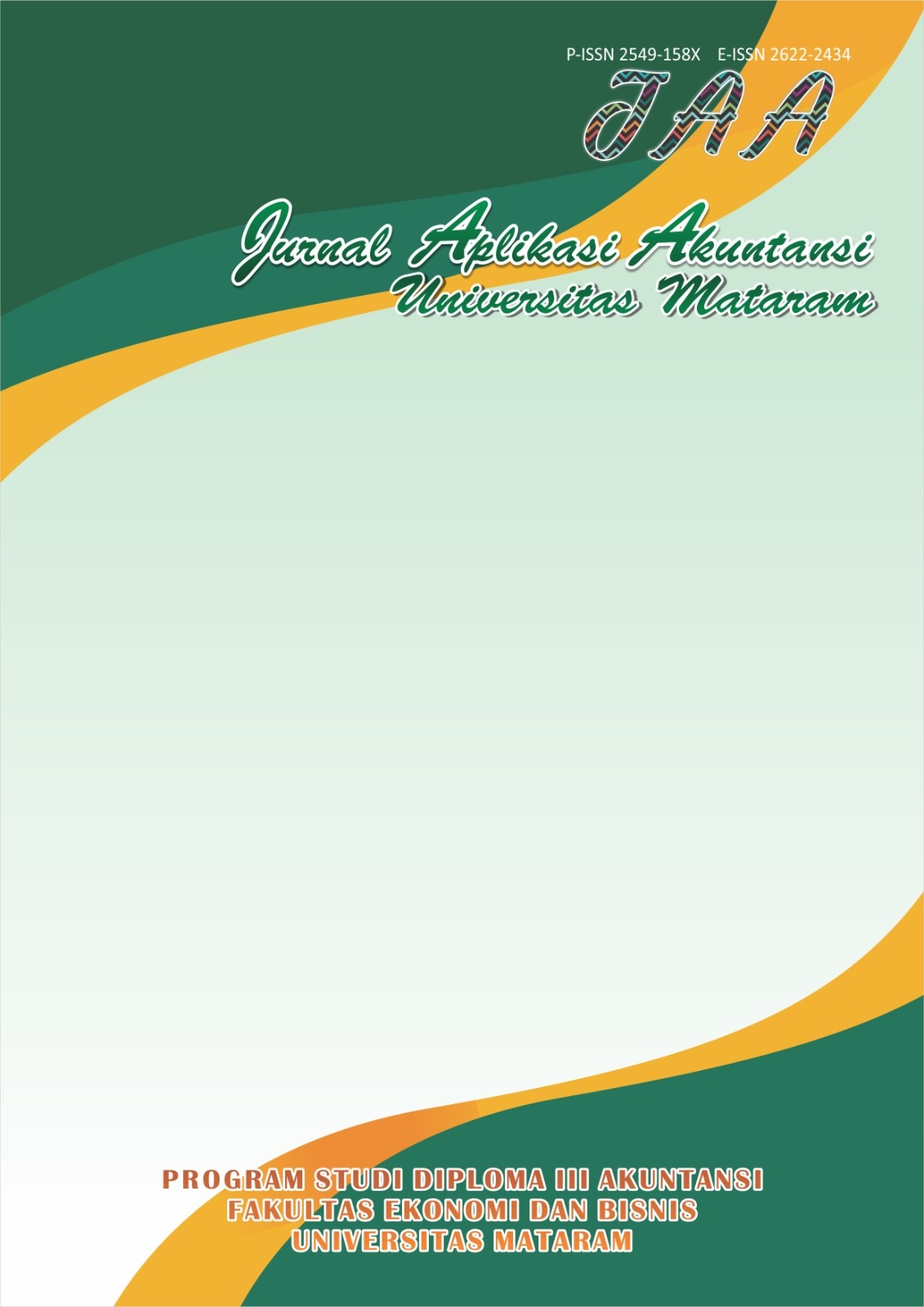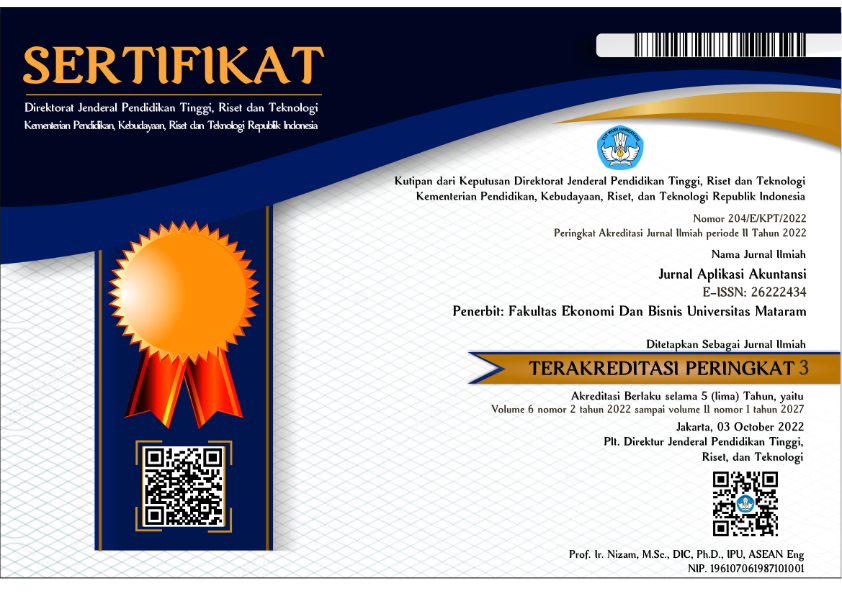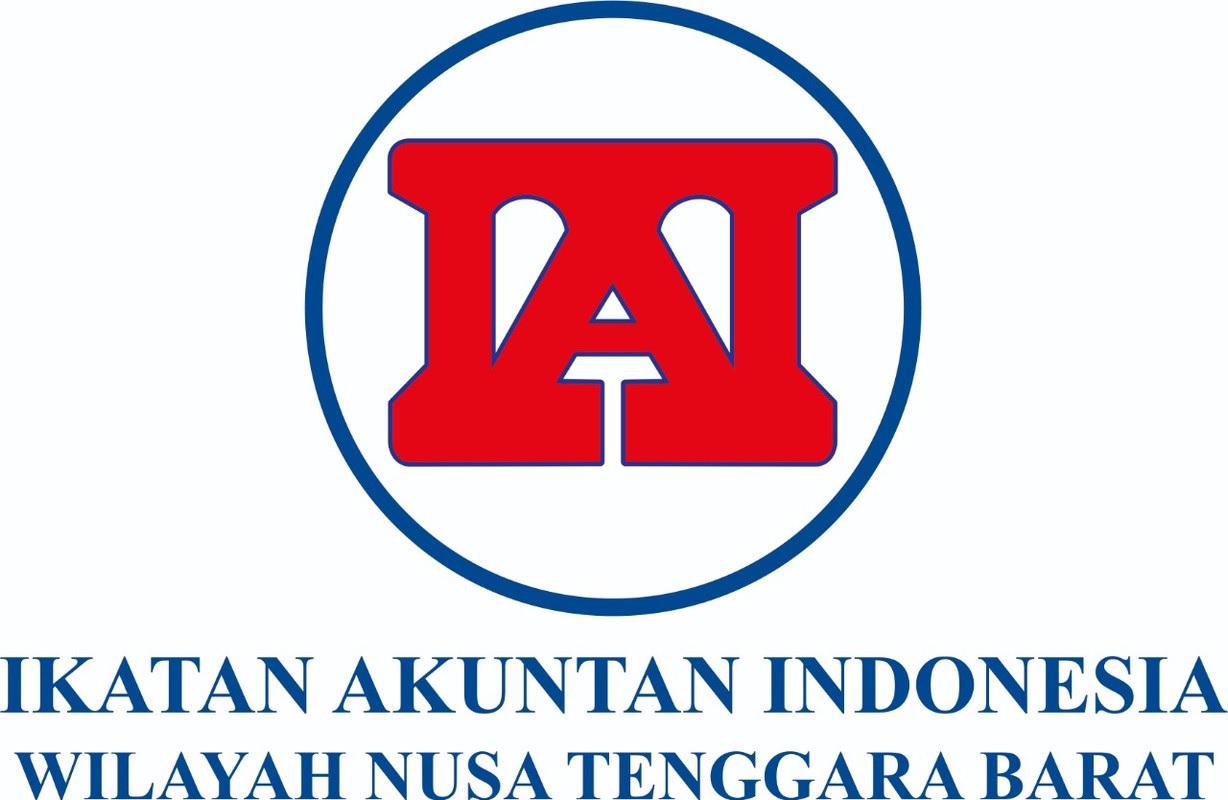ANALISIS DETERMINAN INTENSI DAN PERILAKU PENGGUNAAN CHATGPT DALAM PEMBELAJARAN AKUNTANSI
DOI:
https://doi.org/10.29303/jaa.v9i2.545Keywords:
ChatGPT, intensi penggunaan, mahasiswa akuntansi, perilaku penggunaanAbstract
Penelitian ini bertujuan untuk memahami faktor-faktor yang memengaruhi intensi dan perilaku penggunaan teknologi ChatGPT pada mahasiswa akuntansi di Provinsi Bali. Pada akhirnya dapat menciptakan ketergantungan berlebihan pada ChatGPT yang dapat berdampak negatif pada kemampuan berpikir kritis dan pemecahan masalah mahasiswa akuntansi. Variabel dalam kerangka model UTAUT dapat menentukan pengaruh terhadap intensi dan perilaku penggunaan ChatGPT pada mahasiswa akuntansi di Provinsi Bali, namun masih terdapat keterbatasan dalam komprehensifitas aspek keperilakuan. Oleh karena itu, penelitian ini mengembangkan model teori UTAUT menjadi UTAUT2 dengan tambahan variabel perceived risks dan trust untuk menutup celah penelitian sebelumnya. Penelitian ini mengeksplorasi variabel yang mencakup aspek performance expectancy, effort expectancy, social influence, facilitating conditions, hedonic motivation, price value, habit, dan perceived risks, serta juga mencakup trust untuk menilai dampaknya terhadap intensi dan perilaku penggunaan ChatGPT. Pendekatan kuantitatif asosiatif digunakan untuk mengidentifikasi hubungan sebab-akibat antar variabel dengan metode SEM-PLS. Ada beberapa faktor yang dapat mempengaruhi intensi dan waktu penggunaan yaitu di antaranya Trust (Tr) dan Habit (Ha) yang memberikan pengaruh positif, variabel yang lain tidak memberikan pengaruh. Temuan diharapkan dapat memberikan kontribusi praktis bagi pengembangan atau adopsi teknologi AI di pendidikan akuntansi, khususnya untuk meningkatkan efektivitas pembelajaran mahasiswa.
References
Abeysekera, I. (2024). ChatGPT and academia on accounting assessments. Journal of Open Innovation: Technology, Market, and Complexity, 10(1), 100213. https://doi.org/10.1016/j.joitmc.2024.100213
Abikari, M. (2024). Emotions, perceived risks and intentions to adopt emerging e-banking technology amongst educated young consumers. International Journal of Bank Marketing, 42(5), 1036–1058. https://doi.org/10.1108/IJBM-01-2023-0004
Akbar, M. (2021). Investigating the Intentions to Adopt E-Learning using UTAUT-3 model: A Perspective of COVID-19. SSRN Electronic Journal, 1–11. https://doi.org/10.2139/ssrn.3884450
Ali Abbasi, G., Abdul Rahim, N. F., Wu, H., Iranmanesh, M., & Keong, B. N. C. (2022). Determinants of SME's Social Media Marketing Adoption: Competitive Industry as a Moderator. SAGE Open, 12(1). https://doi.org/10.1177/21582440211067220
Awang, Y., Taib, A., Shuhidan, S. M., Zakaria, Z. N. Z., Ifada, L. M., & Sulistyowati, S. (2023). Mapping between Digital Competencies and Digitalization of the Accounting Profession among Postgraduate Accounting Students. Asian Journal of University Education, 19(1), 83–94. https://doi.org/10.24191/ajue.v19i1.21226
Ayaz, A., & Yanartaş, M. (2020). An analysis on the unified theory of acceptance and use of technology theory (UTAUT): Acceptance of electronic document management system (EDMS). Computers in Human Behavior Reports, 2(September). https://doi.org/10.1016/j.chbr.2020.100032
Budhathoki, T., Zirar, A., Njoya, E. T., & Timsina, A. (2024). ChatGPT adoption and anxiety: a cross-country analysis utilising the unified theory of acceptance and use of technology (UTAUT). Studies in Higher Education, 49(5), 831–846. https://doi.org/10.1080/03075079.2024.2333937
Budhwar, P., Chowdhury, S., Wood, G., Aguinis, H., Bamber, G. J., Beltran, J. R., Boselie, P., Lee Cooke, F., Decker, S., DeNisi, A., Dey, P. K., Guest, D., Knoblich, A. J., Malik, A., Paauwe, J., Papagiannidis, S., Patel, C., Pereira, V., Ren, S., … Varma, A. (2023). Human reSumber management in the age of generative artificial intelligence: Perspectives and research directions on ChatGPT. Human ReSumber Management Journal, 33(3), 606–659. https://doi.org/10.1111/1748-8583.12524
Cardoso, A., Gabriel, M., Figueiredo, J., Oliveira, I., Rêgo, R., Silva, R., Oliveira, M., & Meirinhos, G. (2022). Trust and Loyalty in Building the Brand Relationship with the Customer: Empirical Analysis in a Retail Chain in Northern Brazil. Journal of Open Innovation: Technology, Market, and Complexity, 8(3). https://doi.org/10.3390/joitmc8030109
Chai, C. S., Lin, P. Y., Jong, M. S. Y., Dai, Y., Chiu, T. K. F., & Qin, J. (2021). Perceptions of and Behavioral Intentions towards Learning Artificial Intelligence in Primary School Students. Educational Technology and Society, 24(3), 89–101.
Chaveesuk, S., Khalid, B., Bsoul-Kopowska, M., Rostanska, E., & Chaiyasoonthorn, W. (2022). Comparative analysis of variables that influence behavioral intention to use MOOCs. PLoS ONE, 17(4 April), 1–26. https://doi.org/10.1371/journal.pone.0262037
Cortez, P. M., Ong, A. K. S., Diaz, J. F. T., German, J. D., & Singh Jagdeep, S. J. S. (2024). Analyzing Preceding factors affecting behavioral intention on communicational artificial intelligence as an educational tool. Heliyon, 10(3), e25896. https://doi.org/10.1016/j.heliyon.2024.e25896
Dionika, B., Irwansyah, I., & Safira, M. (2020). The Acceptance And Use of Digital Public Service: An Influence of Trust and An Application of UTAUT2. https://doi.org/10.4108/eai.9-10-2019.2291112
Dwivedi, Y. K., Hughes, L., Kar, A. K., Baabdullah, A. M., Grover, P., Abbas, R., Andreini, D., Abumoghli, I., Barlette, Y., Bunker, D., Chandra Kruse, L., Constantiou, I., Davison, R. M., De, R., Dubey, R., Fenby-Taylor, H., Gupta, B., He, W., Kodama, M., … Wade, M. (2022). Climate change and COP26: Are digital technologies and information management part of the problem or the solution? An editorial reflection and call to action. International Journal of Information Management, 63(November 2021). https://doi.org/10.1016/j.ijinfomgt.2021.102456
Eloundou, T., Manning, S., Mishkin, P., & Rock, D. (2023). GPTs are GPTs: An Early Look at the Labor Market Impact Potential of Large Language Models. http://arxiv.org/abs/2303.10130
Fitrianie, S., Horsch, C., Beun, R. J., Griffioen-Both, F., & Brinkman, W. P. (2021). Factors Affecting User's Behavioral Intention and Use of a Mobile-Phone-Delivered Cognitive Behavioral Therapy for Insomnia: A Small-Scale UTAUT Analysis. Journal of Medical Systems, 45(12). https://doi.org/10.1007/s10916-021-01785-w
Foroughi, B., Senali, M. G., Iranmanesh, M., Khanfar, A., Ghobakhloo, M., Annamalai, N., & Naghmeh-Abbaspour, B. (2024). Determinants of Intention to Use ChatGPT for Educational Purposes: Findings from PLS-SEM and fsQCA. International Journal of Human–Computer Interaction, 40(17), 4501–4520. https://doi.org/10.1080/10447318.2023.2226495
Gatzioufa, P., & Saprikis, V. (2022). A literature review on users' behavioral intention toward chatbots' adoption. Applied Computing and Informatics. https://doi.org/10.1108/ACI-01-2022-0021
Gunasinghe, A., Hamid, J. A., Khatibi, A., & Azam, S. M. F. (2020). The adequacy of UTAUT-3 in interpreting academician's adoption to e-Learning in higher education environments. Interactive Technology and Smart Education, 17(1), 86–106. https://doi.org/10.1108/ITSE-05-2019-0020
Hair, J. F., Matthews, L. M., Matthews, R. L., & Sarstedt, M. (2017). Updated guidelines on which method to use. International Journal of Multivariate Data Analysis, 1(2), 107.
Handoko, B. L., & Prianto, J. A. (2020). The influence of UTAUT on ERP systems in start-up business. International Journal of Management, 11(4), 262–271. https://doi.org/10.34218/IJM.11.4.2020.027
Hasanein, A. M., & Sobaih, A. E. E. (2023). Drivers and Consequences of ChatGPT Use in Higher Education: Key Stakeholder Perspectives. European Journal of Investigation in Health, Psychology and Education, 13(11), 2599–2614. https://doi.org/10.3390/ejihpe13110181
Kanbach, D. K., Heiduk, L., Blueher, G., Schreiter, M., & Lahmann, A. (2024). The GenAI is out of the bottle: generative artificial intelligence from a business model innovation perspective. In Review of Managerial Science (Vol. 18, Issue 4). Springer Berlin Heidelberg. https://doi.org/10.1007/s11846-023-00696-z
Kumar, S., Goel, U., Joshi, P., & Johri, A. (2024). Factors affecting Information & Communication Technology (ICT) adoption among MSMEs. Journal of Open Innovation: Technology, Market, and Complexity, 10(1), 100205. https://doi.org/10.1016/j.joitmc.2023.100205
Kurniawan, A. C., Rachmawati, N. L., Ayu, M. M., Ong, A. K. S., & Redi, A. A. N. P. (2024). Determinants of satisfaction and continuance intention towards online food delivery service users in Indonesia post the COVID-19 pandemic. Heliyon, 10(1), e23298. https://doi.org/10.1016/j.heliyon.2023.e23298
Lukyanenko, R., Maass, W., & Storey, V. C. (2022). Trust in artificial intelligence: From a Foundational Trust Framework to emerging research opportunities. Electronic Markets, 32(4), 1993–2020. https://doi.org/10.1007/s12525-022-00605-4
Maghrour Zefreh, M., Edries, B., & Esztergár-Kiss, D. (2023). Understanding the antecedents of hedonic motivation in autonomous vehicle technology acceptance domain: A cross-country analysis. Technology in Society, 74(July). https://doi.org/10.1016/j.techsoc.2023.102314
Mai, D. T. T., Da, C. Van, & Hanh, N. Van. (2024). The use of ChatGPT in teaching and learning: a systematic review through SWOT analysis approach. Frontiers in Education, 9(February), 1–17. https://doi.org/10.3389/feduc.2024.1328769
Masa'deh, R., Majali, S. A. L., Alkhaffaf, M., Thurasamy, R., Almajali, D., Altarawneh, K., Al-Sherideh, A., & Altarawni, I. (2024). Antecedents of adoption and usage of ChatGPT among Jordanian university students: Empirical study. International Journal of Data and Network Science, 8(2), 1099–1110. https://doi.org/10.5267/j.ijdns.2023.11.024
Maulidina, P. R., Sarno, R., Sungkono, K. R., & Giranita, T. A. (2020). Using extended UTAUT2 Model to Determine Factors Influencing the Use of Shopee E-commerce. Proceedings - 2020 International Seminar on Application for Technology of Information and Communication: IT Challenges for Sustainability, Scalability, and Security in the Age of Digital Disruption, ISemantic 2020, 493–498. https://doi.org/10.1109/iSemantic50169.2020.9234255
Menon, D., & Shilpa, K. (2023). "Chatting with ChatGPT": Analyzing the factors influencing users' intention to Use the Open AI's ChatGPT using the UTAUT model. Heliyon, 9(11), e20962. https://doi.org/10.1016/j.heliyon.2023.e20962
Misra, R., Mahajan, R., Singh, N., Khorana, S., & Rana, N. P. (2022). Factors impacting behavioural intentions to adopt the electronic marketplace: findings from small businesses in India. Electronic Markets, 32(3), 1639–1660. https://doi.org/10.1007/s12525-022-00578-4
Mpaata, E., Koskei, N., & Saina, E. (2020). Social influence And Savings Behavior: Evidence From A Developing Country Context. SEISENSE Journal of Management, 3(4), 56–67. https://doi.org/10.33215/sjom.v3i4.396
Munandar, J. M., & Munthe, R. C. F. (2019). How Technology Affects Behavioral Intention (Case Study of Online Transportation in Indonesia and Thailand). The South East Asian Journal of Management, 13(2), 222–236. https://doi.org/10.21002/seam.v13i2.11343
Nascimento, A., & Meirelles, F. (2022). An Artificial Intelligence Adoption Model for Large and Small Businesses. SSRN Electronic Journal, 1–20. https://doi.org/10.2139/ssrn.4194043
Obaid, O. I., Ali, A. H., & Yaseen, M. G. (2023). Impact of chat GPT on scientific research: Opportunities, risks, limitations, and ethical issues. Iraqi Journal for Computer Science and Mathematics, 4(4), 13–17. https://doi.org/10.52866/ijcsm.2023.04.04.002
Ogbo, E., Brown, T., Gant, J., & Sicker, D. (2021). When being connected is not enough. 11.
Pascucci, F., Savelli, E., & Gistri, G. (2023). How digital technologies reshape marketing: evidence from a qualitative investigation. Italian Journal of Marketing, 27–58. https://doi.org/10.1007/s43039-023-00063-6
Patil, P., Tamilmani, K., Rana, N. P., & Raghavan, V. (2020). Understanding consumer adoption of mobile payment in India: Extending Meta-UTAUT model with personal innovativeness, anxiety, trust, and grievance redressal. International Journal of Information Management, 54. https://doi.org/10.1016/j.ijinfomgt.2020.102144
Pratiwi, N. P. D., Ariyanto, D., Putra, I. N. W. A., & Mimba, N. P. S. H. (2022). Penilaian Kesuksesan Penerapan Xero Accounting Software Dengan Model UTAUT dan Delone & McLean. E-Jurnal Akuntansi, 32(2), 3764. https://doi.org/10.24843/eja.2022.v32.i02.p13
Putra Hardian, A. (2019). KINERJA KEUANGAN DAN UKURAN PERUSAHAAN TERHADAP NILAI PERUSAHAAN, CSR SEBAGAI VARIABEL MODERASI Nur Fadjrih Asyik Sekolah Tinggi Ilmu Ekonomi Indonesia (STIESIA) Surabaya. Jurnal Ilmu Dan Riset Akuntansi, 5(9), 1–16.
Putri, N., & Yuliati, E. (2022). The Effect of Perceived risks on Customer's Behavioral Intention of Digital Gold Platform: The Moderating Role of Trust. https://doi.org/10.4108/eai.27-7-2021.2316918
Reinartz, W., Wiegand, N., & Imschloss, M. (2019). The impact of digital transformation on the retailing value chain. International Journal of Research in Marketing, 36(3), 350–366. https://doi.org/10.1016/j.ijresmar.2018.12.002
Salifu, I., Arthur, F., Arkorful, V., Abam Nortey, S., & Solomon Osei-Yaw, R. (2024). Economics students' behavioural intention and usage of ChatGPT in higher education: a hybrid structural equation modelling-artificial neural network approach. Cogent Social Sciences, 10(1). https://doi.org/10.1080/23311886.2023.2300177
Sarosa, S. (2021). The effect of perceived risks and perceived cost on using online learning by high school students. Procedia Computer Science, 197(2021), 477–483. https://doi.org/10.1016/j.procs.2021.12.164
Sobaih, A. E. E., Elshaer, I. A., & Hasanein, A. M. (2024). Examining Students' Acceptance and Use of ChatGPT in Saudi Arabian Higher Education. European Journal of Investigation in Health, Psychology and Education, 14(3), 709–721. https://doi.org/10.3390/ejihpe14030047
Suyatmini, Sutama, Rohmah, W., & Asmawati, T. (2021). Quality Improvement of Contextual Accounting Learning Management Based on Lesson Study in Senior High School. Proceedings of the 5th Progressive and Fun Education International Conference (PFEIC 2020), 479, 162–165. https://doi.org/10.2991/assehr.k.201015.025
Tjokrosaputro, M., & Cokki, C. (2020). The Role of Social influence Towards Purchase Intention With Value Perception as Mediator: A Study on Starbucks Coffee as an Environmentally Friendly Product. 145(Icebm 2019), 183–189. https://doi.org/10.2991/aebmr.k.200626.034
Venkatesh, V., Morris, M. G., Davis, G. B., & Davis, F. D. (2003). User Acceptance of Information: Towar a Unified View. MIS Quarterly, 27(3), 425–478. https://www.jstor.org/sTabel/30036540
Venkatesh, V., Thong, J. Y., & Xu, X. (2012). Consumer Acceptance and Use of Information Technology: Extending the Unified Theory of Acceptance and Use of Technology by Viswanath Venkatesh, James Y.L. Thong, Xin Xu: SSRN. MIS Quarterly, 36(1), 157–178. https://papers.ssrn.com/sol3/papers.cfm?abstract_id=2002388
Wang, D., Chen, Y., Tuguinay, J., & Yuan, J. J. (2023). The Influence of Perceived risks and Behavioral Intention: The Case of Chinese International Students. SAGE Open, 13(2), 1–17. https://doi.org/10.1177/21582440231183435
Widyanto, H. A., Kusumawardani, K. A., & Yohanes, H. (2022). Safety first: extending UTAUT to better predict mobile payment adoption by incorporating perceived security, perceived risks and trust. Journal of Science and Technology Policy Management, 13(4), 952–973. https://doi.org/10.1108/JSTPM-03-2020-0058
Wirdiyanti, R., Simatupang, M., Yusgiantoro, I., & Ashar, H. (2021). Corporate Loan Default Determinants in Indonesia. Financial Services Authority Research Seminar, November. www.ojk.go.id
Zamzami, E. M., Timanta Tarigan, J., Jaya, I., Melvani Hardi, S., & Fadly Syah Putra, M. (2019). Designing Open Server for Educational Question ReSumber. Journal of Physics: Conference Series, 1235(1). https://doi.org/10.1088/1742-6596/1235/1/012091
Zhang, X., & Yu, X. (2020). The Impact of Perceived risks on Consumers' Cross-Platform Buying Behavior. Frontiers in Psychology, 11(October), 1–13. https://doi.org/10.3389/fpsyg.2020.592246
Ziemba, E. W., Maruszewska, E. W., Grabara, D., & Renik, K. (2024). Acceptance and Use of ChatGPT Among Accounting and Finance Higher Education Students BT - Emerging Challenges in Intelligent Management Information Systems (M. Hernes & J. Wątróbski (eds.); pp. 185–202). Springer Nature Switzerland.
Downloads
Published
How to Cite
Issue
Section
License
Copyright (c) 2025 Putu Eka Dianita Marvilianti Dewi, Ni Luh Nyoman Sherina Devi, I Gusti Agung Prama Yoga

This work is licensed under a Creative Commons Attribution-NonCommercial-ShareAlike 4.0 International License.









